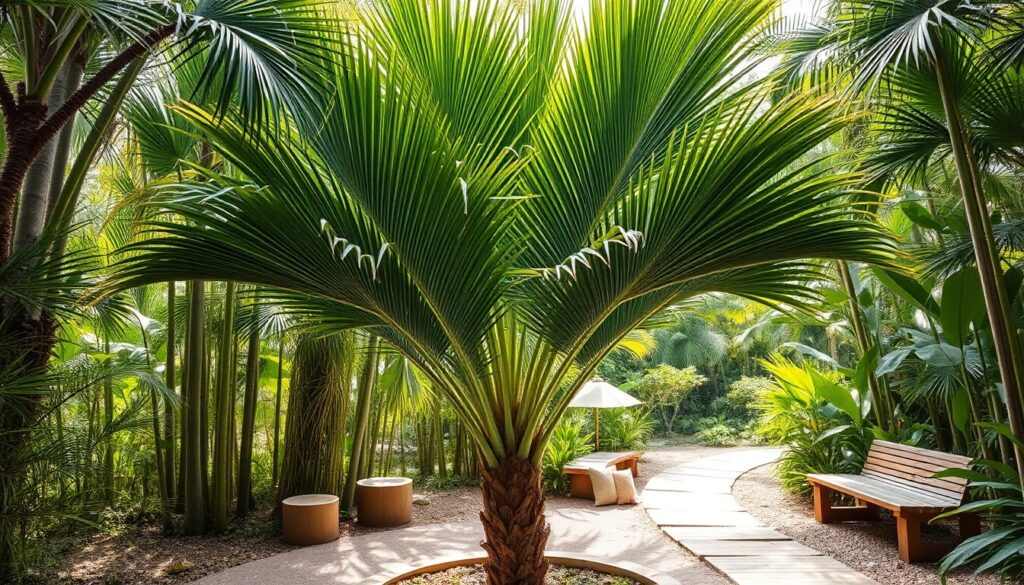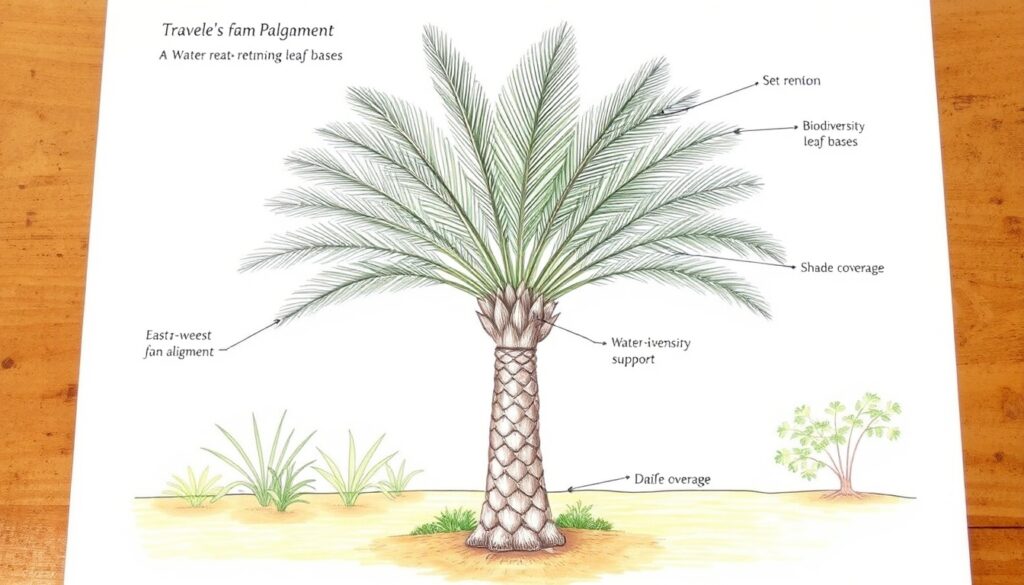The plant is an iconic fan-shaped plant from Madagascar also called the Travelers Palm due to its ancient use as a guidance and protection symbol. While not technically a palm – it is part of the Strelitziaceae family- this impressive plant receives international acclaim for its architectural aesthetics and environmentally friendly attributes. Meanwhile, for luxury or sustainable landscaping, a traveler’s palm is not only an ornament but also an environmentally friendly decision that corresponds to the principles of ethical landscaping. This blog post explores the basics of ethical landscaping and how the ageless traveler’s palm can be a sustainable and stylish option.

Table of Contents
What is Ethical Landscaping?
Ethical landscaping is the practice of creating outdoor spaces that prioritize environmental health, resource efficiency, and conservation of biological diversities and reducing human interference with the earth’s natural systems. Key principles include:
Low Resource Use: Lowering of water, energy and chemical consumptions.
Biodiversity Support: Purchasing plants that other pollinators and local wildlife will be drawn to as well.
Climate Adaptation: Selecting plants appropriate to the climate, not using plants that are considered to be invasive, and seeking to have lower levels of carbon emissions.
Cultural Responsibility: The principles of the use of plants and landscaping to respect the cultural aspect and use native or well-adapted species to give support to the weak local ecosystems.
When incorporated well, the Traveler’s Palm does all these and therefore contributes to the achievement of goals of designing ethical and luxurious spaces.
The Botanical Beauty and Benefits of the Traveler’s Palm
The Traveler’s Palm (Ravenala madagascariensis) grows up to 30 feet with fan-like leaves spanning out in a unique east-west alignment. This alignment traditionally helped travelers navigate and also inspired its name. The plant’s structure, large leaf surface, and water-storing abilities make it both functional and ornamental, enhancing garden aesthetics with minimal environmental impact.
Key features that make the Traveler’s Palm suitable for ethical landscaping include:
- Water Conservation: It has adapted to the environment in a way that makes it a low water plant compared to other ornamental plants.
- Minimal Chemical Dependency: The Traveler’s Palm is not an invasive species and does not need chemical fertilizers or pesticides which decreases pollution and runoff.
- Wildlife Attraction: Beauty of this plant is that it has flowers that bees, birds, and bats visit to feed on hence helping to support the pollinators that are so vital to local ecosystems.
How to Incorporate the Traveler’s Palm in Ethical Landscaping Design
When designing with the Travelers Palm, consider its visual and environmental contributions to the landscape. Here are some best practices to ensure its placement supports sustainable and ethical landscaping goals:
1. Positioning for Maximum Impact and Natural Cooling
Through large leaves of the Travelers Palm, there are places that are shaded naturally and people can use them to relax without having to be cooled mechanically. Put it in a position whereby it will block windows or seating arrangements from direct sun light, reduce heat and control the climate of the surrounding. It should also respect its most famous geographical feature, the east-west orientation of its layout, providing a natural north-south orientation, which was once used as a reference point for travelers.
2. Water Management and Irrigation
By the way, for the properties that are expected to minimize water consumption, this palm is suitable because the plant stores water naturally. To improve this feature in or in regions prone to drought or with sensitive water systems, it is advisable to combine it with other low water demand plants, and use rain water harvesting methods. It can be recommended to create small water pools around the base of the plant so that it grows using the rain water that falls on the ground.
3. Supporting Biodiversity and Habitat Creation
When you combine the Travelers Palm with native grasses, flowering shrubs and ground covers, you have a progressive ecological system that fosters the presence of other living things. Bees, birds and bats are drawn to its flowers and are important partners in the pollination of flowers and vegetables in the garden as well as in pest control. It also consolidates a better environment for crops that ensures least use of chemical pest control methods.

4. Pairing with Other Sustainable Elements
Thus, it is possible to emphasize the Tree as a monolith by using other environmentally friendly materials, including bamboo or recycled stone for walks or seats. The plant’s appearance is quite dominant and goes well with rough natural finishes, intertwined with the spirit of luxury and environmental friendliness. Also, combining the Travelers Palm with other low-input tropical plants like bromeliads or ferns, which will also provide a natural look.
5. Integrating Cultural and Historical Appreciation
Even if the tree is used in an ethical landscaping design then it can also respect its history and culture of the country. Draw attention to its symbolism in the landscape design through sculptures, meditation areas or information boards that provide information about its history, and use in sustainable practice. In luxury ecological environment, such accessories generate an appealing, purposeful experience for the guests and the residents.
Practical Tips for Growing and Maintaining the Traveler’s Palm Ethically
While the Travelers Palm is relatively low maintenance, a few care practices ensure it remains healthy without compromising its ecological role.
- Soil and Light Requirements: The plant grows best in well drained soil and in those soils which are rich in organic matter. It also needs full to partial sun, which makes it perfect for exposed areas in an ethical landscape.
- Pruning and Cleanup: Trim the foliage often to enhance the clean looking of the plant and to deter pests. Do not cut too many leaves as the plant loses older ones and it is normal.
- Avoid Overwatering: The Traveler’s Palm is moderately drought tolerant. This may cause root rot or wastage of water hence should be done only if the soil feels dry.

Why the Traveler’s Palm Represents Timeless, Ethical Luxury
Opulence does not equal environmentally unfriendly anymore. Some of the species of plants which are used in landscaping are Ethical Landscape Plants and these include the Travelers palm. The timelessness of its structure, flexibility and the cultural significance all serve to present a poignant message on the consumerist approach to the world’s natural endowment. As for the Travelers Palm when combined with proper landscaping it enhances exterior environments, combining sophistication with sustainability.
Conclusion
Eco-friendly landscaping is not just the new fad; it is the way forward to designing sustainable and aesthetically pleasing designs that are sustainable. The Traveler’s Palm has so much history behind it and is such an environmentally friendly tree and those landscapes looking for luxury without ostentation are those that would look best with this tree. When incorporating this famous plant into our design we not only enhance our surroundings but also contribute to the eco-conscious design process. Being a permanent part of ethical luxury environments, the Traveler’s Palm remains a decoration and a reference to the aesthetics of nature.
Seize this ageless ally to form exquisite and environmentally sensitive landscapes that lead us to the future as it led those early wayfarers of the wilderness.
Share this content:

